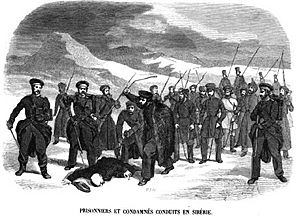Convict facts for kids
A convict is a person who has been found guilty of a crime by a court. They are usually serving a sentence, often in prison. You might also hear them called "prisoners" or "inmates." A common slang term is "con." Someone who used to be a convict, especially after leaving prison, is sometimes called an "ex-con." People who get other kinds of punishments, like community service, are usually not called convicts.
Being an "ex-convict" can sometimes make life harder. It might mean people judge you, or it could be harder to find a job. For example, the federal government of Australia usually doesn't hire ex-convicts. Some state governments might also have rules about how long after their sentence someone can be employed.
Contents
Convicts in History


The word "convict" was used a lot in the English-speaking world to describe the many criminals in British prisons during the 1700s and early 1800s. Their crimes would often seem minor today. This included stealing small items or food. Some crimes, like being in debt, are not even against the law anymore.
Punishments at this time were very harsh. Even for small crimes, people could be sentenced to death by hanging. However, this death sentence was often changed to a lesser punishment. A common punishment was "transportation." This meant being sent far away to a new colony for 7 or 14 years, or even for life. So, in Britain, "convict" often meant someone who was sent overseas as punishment.
Transportation to the Americas
At first, many British convicts were sent to the American colonies. Places like Maryland, Virginia, and Georgia used them as cheap workers. The British started sending convicts overseas around 1615. This became more common over the years.
Most convicts were first sent to North America or the West Indies. After 1718, all transportation went to North America. This system stopped when the War of Independence began. Britain could no longer send convicts to North America.
Convicts in Australia
After losing the American colonies, the British government looked for a new place. They chose the newly explored east coast of Australia as a penal colony. This was a place specifically for prisoners. Convicts were first sent to Australia in 1787. They arrived in Botany Bay, then Sydney Cove, in January 1788.
From the very beginning of European settlement, convicts were used as workers. This happened in five out of the six colonies. Many worked on public projects, like building roads. A large number were also "assigned" to private people. They worked as house servants or farm workers. Transportation slowly ended starting in 1853. It stopped completely in 1868.
In Australia, convicts have become important figures in the country's stories and history. Many former convicts became successful business people and respected citizens. Some important families in Australia today can trace their roots back to convict ancestors. These ancestors often rose from very humble beginnings.
However, during the time of transportation and for many years after, former convicts and their families often hid their past. This sometimes led to missing or changed family histories. Today, very detailed records were kept on every convict. These records can now help fill in those missing parts. In fact, many family historians can find out more about their convict ancestors than about their ancestors who came to Australia as free settlers.
Other Places for Convicts
British convicts were also sent to Canada, West Africa, and India. France also sent convicts to places like French Guiana and New Caledonia. Russian criminals who were sent to Siberia can also be thought of as convicts.
Related pages


